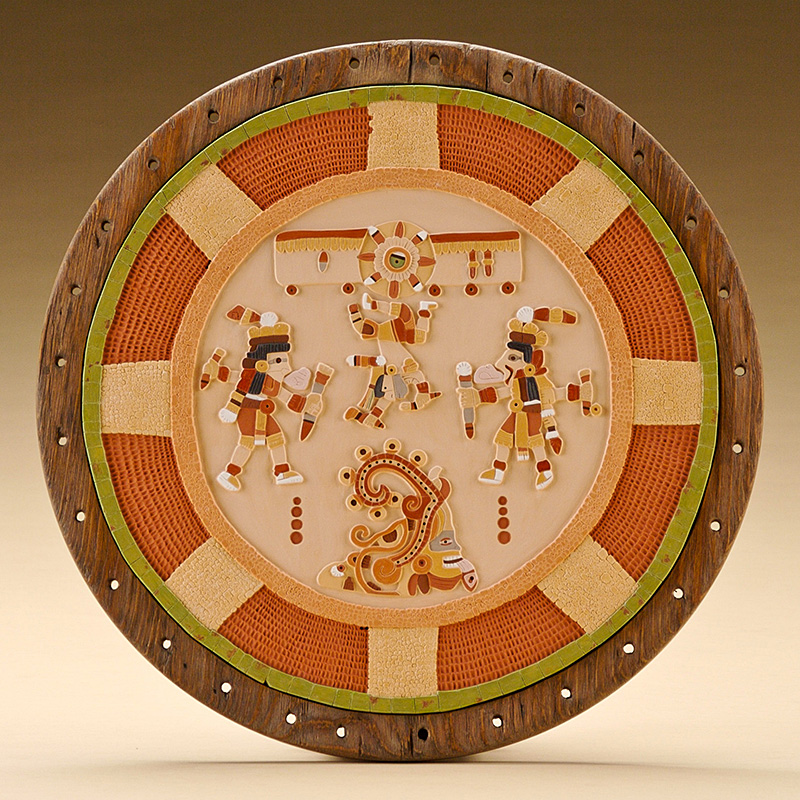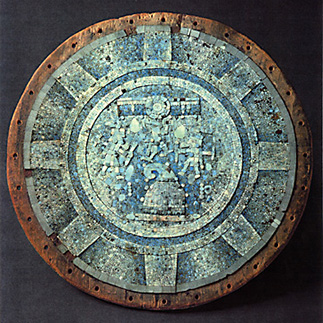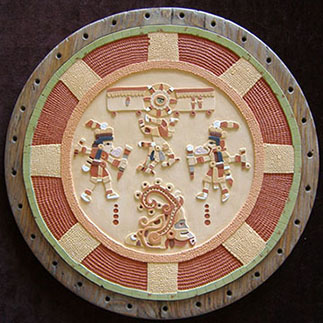STATUS: Sold
PRICE: $21,000
Mixtec Shield, wood base, IEEE Research papers
The “Heaven of the Suns” ceramic shield was inspired by a prehistoric Mixtec shield (called a ‘Chimalli’) Al found and studied in the vaults of the National Museum of the American Indian. An article on this Shield appears on page 53 of the summer 2007 issue of the NMAI Indian Magazine. The 14,000 pieces of turquoise used is referred to by the Aztecs as Teoxihuitl, or “Turquoise of the Gods.” Artistically, the shield sheds light in an area of relatively unknown pre-history.
Al calls this strikingly beautiful piece “Heaven of the Suns”. The shield design represents a time when there was a highly significant celestial “event”. A brilliant display, potentially as brilliant as the sun, like the northern lights, but 100 times more intense.
The horizontal image at the top reflects the sky and the sun with vertical feathers representing the rays of the sun. The sun symbol is similar to the Hopi sun symbol, “Taawa”. The images to the right and left are warriors, wearing eagle feathers and carrying ceremonial scepters, escorting the “event” messenger descending from the sun.
The bottom glyph or image is known as the Turquoise God, Xiuhtecutli and also represents a sacred mountain known as the twisted mountain of Colhuacan. The seven circles on the head dress are the seven signs of the constellation of Pleiades. The “pointed” tongue represents a constant struggle with the “Sun” which had taken over the night. The color patterns in the characters were also determined after Al’s extensive historical research.
Heaven of the Suns – Cosmological Discovery
Shields, using inlaid polished turquoise from Cerrillos, New Mexico, have been found as far away as Central America. The Mixtec are ancient cultural relatives of the Hopi who speak a southern dialect of “Uto-Aztecan”. The Hopi language is a Northern dialect of “Uto-Aztecan”. Shield images are found painted in kiva murals at Pottery Mound, a site located just west of Albuquerque. Many of the Pottery Mound mural images also have designs like those found on pottery at the Hopi village of Sikyatki where Al’s Coyote clan ancestors resided. Artistically the shield sheds light in an area of relatively unknown prehistory.
Al believes the shield glyphs represent a time when there was a highly visiable celestial event observed by all mankind in antiquity. A brilliant display, potentially as brilliant as the sun at Earth’s polar axes; an Aurora Borealis-Australis (Northern and Southern Lights), but 100 times more intense as those seen at the Arctic and Antarctica today. Surely an awe inspiring and potentially terrifying long term event observable over the entire Earth, long thought by astronomers to have occurred in prehistoric time.
The horizontal image at the top reflects the sky and the sun, with the vertical feathers representing the rays of the sun. The sun symbol is similar to the Hopi sun symbol, “Taawa”. The images to the right and left are warrior’s, wearing eagle feathers and carrying ceremonial scepters escorting the “event” messenger descending from Sun. Both warriors are singing as represented by the pink “voice” balloons…like in modern comic books…these also are represented at Pottery Mound.
As previously noted, turquoise was highly symbolic and the most highly prized of minerals. The “pointed” tongue is formed like an obsidian knife, turned outwards, representing a constant struggle with the “Sun” (the “event”) which had “taken over the night”. The color patterns in the characters were determined after much reseach of written materials, where existing, and codices.
In a recent discovery something startling was revealed in this shield design. There are 112 turquoise inlays around the periphery rim, as in the shield at NMAI. The wooden frame carries 28 holes. This discovery at Los Alamos revealed that in high energy physics experiments replicating the shape and parameters of an intense aurora, very high electrical fields generate a companion magnetic field, creating an intense visible “sheathing” of 112 electrial filaments, twisting into 56 pairs, which can pair again to 28. Further, the “sheathing” are, in reality, a set of double conical “sheaths”. The ratio of the larger sheath diameter divided by the smaller has a ratio of 1.45. The “event” in high energy plasma physics is known as “Z-pinch”. This postulated near-Earth phenomena is thought to have occurred about 5000 years ago, having various phases with time spans of perhaps hundreds of years. This was the time taken for the paired 56 filaments to twist together in pairs to the shield’s (Chimalli’s) 28 dots, each dot representing an intense beam of light directed towards Earth.
The shield at NMAI has this same ratio (1.45) in the outer two diameters. This is perhaps the “memory” of a much earlier event. And as it turns out this is a world wide phenomenon, just now being documented. At Stonehedge, one of the better known sites, the outer circle has 56 holes and the ratio of the outer two circles is 1.45. The characteristics mentioned above occur in petroglyphs and archaic structures world-wide. For example, the floor plans of Buddhist Stupas, or temples often have 56 outer pillars and a concentric floor plan when scaled, overlays the Chimalli with the 1.45 diameter ratio.
When Al began his work he was unaware of the results from Los Alamos. Now the shield has taken on a new, potentially more dramatic, character as part of a new discovery. The shield is very likely a representative of newly discovered world-wide recordings and reconstructions of an ancient intense auroral event or phenomenon seen in the sky by all of our ancestors some 5000 years ago.
The significance of these discoveries and how they begin to fit a pattern is published in a series of articles. The term “plasma” refers to the “fourth state of matter” making up 99.9% of the universe, ions, electrons, protons and ionized dusty matter. The other three states are solid, liquid and gas.




